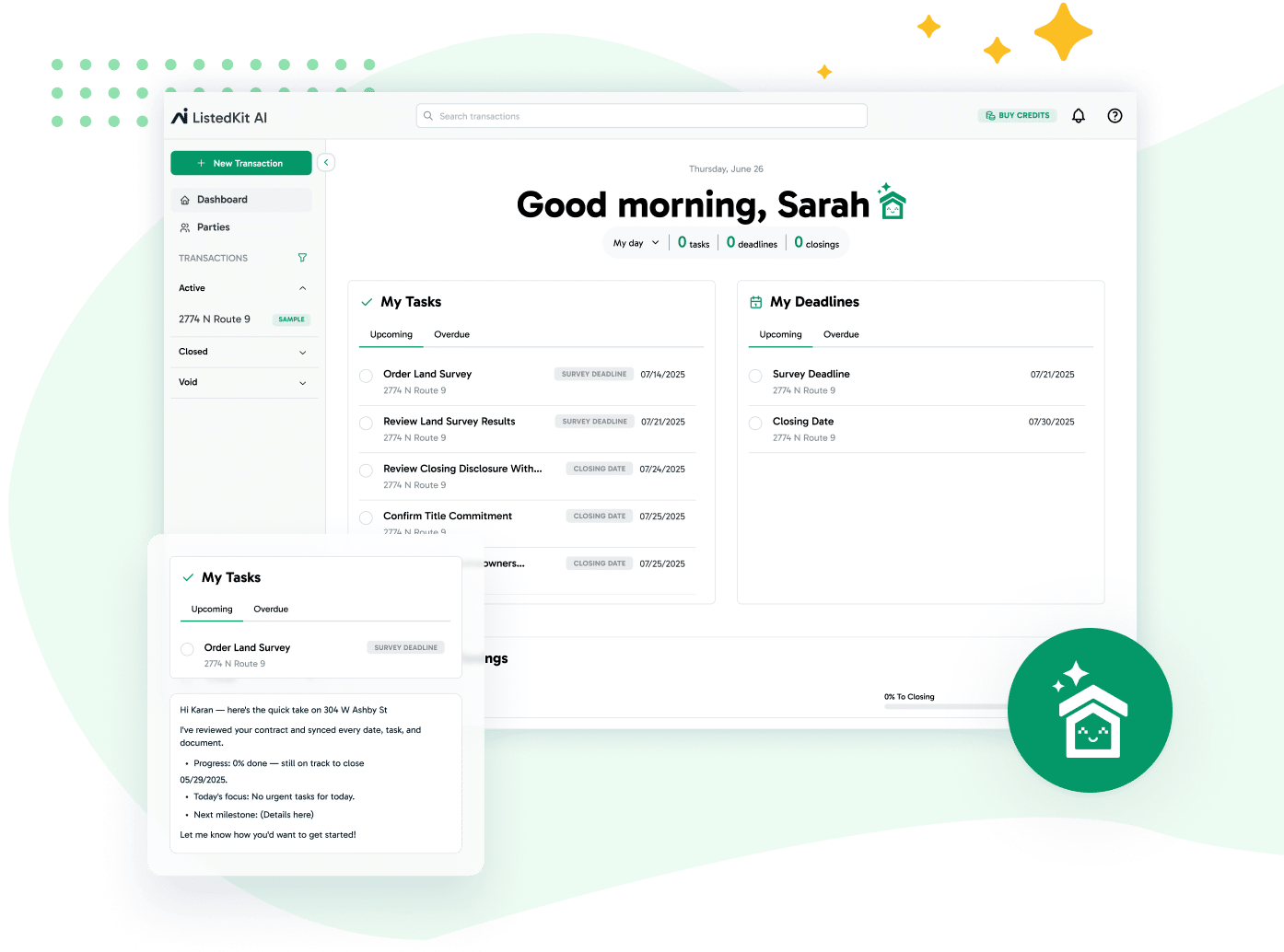Volume discounts provide a strategic means for transaction coordinators (TCs) to cement and continue relationships with real estate agents. By offering agents cost savings with higher transaction volumes, TCs can ensure ongoing business while adding clear value to their partnerships.
This mutually beneficial situation encourages agents to use the same TC services repeatedly, ensuring a continued flow of transactions for the coordinator and operational savings for the agent.
In this article, we review practical strategies for setting effective volume discounts, explore the types of discounts that work best, and offer tips on protecting your bottom line while offering competitive prices.
Understanding Volume Discounts and Their Benefits
Volume discounts refer to price concessions for clients who order more services from a vendor. For real estate transaction coordinators, this means offering lower rates to agents who bring in multiple transactions.
Rather than charging the standard purchase price per transaction, a TC offers special, discounted pricing based on the volume of sales agents drive, making services more attractive and fostering long-term engagement.
Key Benefits of Volume Discounts
- Increased agent loyalty: Volume discounts foster customer loyalty, making agents more likely to stick with a TC that provides meaningful cost savings over time.
- Smooth workflow: Volume discounts help TCs secure a steady flow of transactions, ensuring consistent work and improved business performance.
- Attract new customers: Discounts make a TC’s services more appealing to prospective customers in various segments, helping expand market share and reach new markets.
- Psychological impact: Agents feel they are getting a better deal, making them more likely to return and refer the TC’s services to others, enhancing customer satisfaction and loyalty.
Example: You may offer a 10% discount to agents who complete five or more monthly transactions. The cost savings help retain agents and integrate the TC’s services into their workflow. This type of discount helps TCs build long-term relationships with agents, ensuring a steady business flow and helping meet sales targets.
Types of Volume Discounts That Work Best for Transaction Coordination
When offering discounts to real estate agents, TCs have various options for discount structures to encourage repeat business and loyalty. Each discount type caters to different customer behaviors and can be adjusted to suit TC’s business model, competitive advantage, and profit margins.
Package Volume Discounts
Package volume discounts provide a bundled price for a set number of transactions. Instead of discounting each transaction individually, the TC creates a package deal where agents save money by handling a larger number of deals within a specified period. This model simplifies billing and encourages agents to commit to more deals upfront.
Example: A TC offers a package where agents can purchase transaction coordination services for ten transactions at a discounted rate of $1,500 instead of the usual $2,000. This approach increases sales by encouraging bulk purchases, saving agents money, and strengthening their business relationship with the TC.
Tiered Volume Discounts
Tiered discounts provide progressively larger savings as agents increase their transaction volume. The more transactions they complete, the higher the discount, motivating agents to reach greater levels of business.
Example: A TC charges $300 per transaction for the first five deals in a month, $275 for the next five, and $250 for all transactions beyond ten. These discounts encourage agents to increase transaction volumes, helping achieve incremental sales and long-term growth.
Threshold Volume Discounts
Threshold discounts activate once agents hit a specific transaction volume. After reaching the threshold, all subsequent transactions receive a discount, allowing agents to clearly understand their savings beyond a certain number of deals.
Example: A TC charges full price for the first ten transactions in a month and offers a 15% discount on all subsequent transactions. Agents handling higher volumes benefit from clear savings, which drive sales and foster long-term relationships.
Building Long-Term Relationships with Volume Discounts
Volume discounts offer more than short-term savings—they help establish and maintain long-term relationships between TCs and real estate agents. Here’s how to use volume discounts to strengthen partnerships and deepen customer relationships with real estate agents.
Integrate Your Services into Agents’ Workflows
Volume discounts help TCs become an integral part of an agent’s regular workflow. Offering discounts that align with an agent’s business needs ensures that your services are essential to their daily operations, increasing satisfaction and loyalty.
Offer Specialized Services or Loyalty Rewards
Loyalty programs and added-value services offer benefits beyond discounts, further solidifying the relationship. Examples include priority support, product bundling, or free consultations for agents who consistently meet high-volume thresholds. This demonstrates appreciation and incentivizes continued collaboration.
Regularly Schedule Check-Ins with High-Volume Agents
Regular follow-ups allow TCs to gather customer feedback, address issues, and refine their services to meet the needs of their valued customers better. TCs should communicate frequently with agents who consistently handle high transaction volumes to ensure strong relationships.
Implementing Volume Discounts for Maximum Impact
To ensure volume discounts deliver maximum impact, TCs must adopt a strategic approach that prioritizes clear communication and continuous refinement of their discount structure.
1. Introduce a Strategic, Well-Communicated Plan
Clearly communicate the discount structure to agents, outlining how they can qualify for discounts, the benefits they’ll receive, and any relevant terms. This transparency ensures there’s no customer confusion, allowing agents to understand the value of your offering immediately.
Tip: Keeping a written agreement detailing the specifics of the volume discount terms can prevent misunderstandings and ensure that both you and the agents are on the same page. Tools like ListedKit can help document and manage these agreements efficiently.
2. Set Clear Expectations
Define the exact thresholds, service levels, and terms agents must meet to qualify for discounts. Clarifying your roles and offers on these points ensures smooth business relationships, prevents misunderstandings, and sets a strong foundation for long-term growth.
Tip: Draft a clear guide or document outlining discount tiers, response times, and the overall discount structure, ensuring that agents understand how the pricing model impacts their sales goals.
3. Gather Feedback and Fine-Tune Your Discount Strategy
Collect customer feedback regularly to assess the effectiveness of your discount program. Adjust your offerings based on agent input, market conditions, and changes in operational costs to keep your discount strategy competitive and profitable.
Tip: Consider running quarterly support surveys of your agents on how the discount model supports their business objectives, and modify the structure as needed.
4. Review Profit Margins Regularly
While volume discounts can increase the number of transactions, it is related to keeping an eye on your profit margins regularly to make sure that discounts are affordable and will still allow you to make a good profit. Long-term success balances competitive pricing with profitability.
Tip: Utilize financial analytics tools to track the impact of volume discounts on your bottom line and adjust pricing as needed.
5. Leverage Discounts to Build Partnerships
The volume discount indeed presents an opportunity to strengthen partnerships with agents. Building loyalty perhaps can be achieved by offering support or other services in addition as the agents increase their transaction volume to secure long-term relationships.
Tip: Make sure agents receive priority access to services or dedicated support as a loyalty reward when achieving high-volume thresholds on a consistent basis.
Common Mistakes to Avoid When Offering Volume Discounts
Offering volume discounts is a powerful strategy, but it must be executed carefully to avoid common pitfalls that could harm profitability:
- Offering Discounts That Are Too Steep: Discounts that cut into your profit margins may increase transaction volumes but hurt overall profitability. It’s essential to find the right balance.
- Failing to Set Clear Terms: Without well-defined terms, agents may misunderstand the thresholds or the terms of the discount, leading to issues in customer relationship management.
- Ignoring Operational Costs: As agents buy in larger quantities, operational costs, including administrative costs, increase. Failing to account for this can strain your resources.
Maximizing the Benefits of Volume Discounts for Both Parties
To fully leverage volume discounts, it’s important to ensure they work for both you and your agents. Here are three strategies for maximizing their effectiveness:
- Ensure Transparency: Agents should have a clear understanding of how the discount structure works, helping them align their business goals and target higher transaction volumes.
- Cross-Sell Additional Services: Use volume discounts as an opportunity to introduce agents to complementary products, such as administrative support or software solutions.
- Offer Exclusive Loyalty Perks: Consider offering additional perks, such as referral incentives or discounts for purchases beyond a certain volume, to foster loyalty and drive sales.
Take Advantage of Volume Discounts for Your TC Business
Volume discounts are a good way for real estate transaction coordinators to build relationships. By aligning discounts with business needs, TCs provide cost savings that foster loyalty and business growth. Clear communication, strategic planning, and feedback help ensure that the discount structure remains effective and profitable.
If you want to easily track and store all the documents and make sure you’re updated with all the transactions you have for your clients, you can also use a transaction management tool like ListedKit for that.




